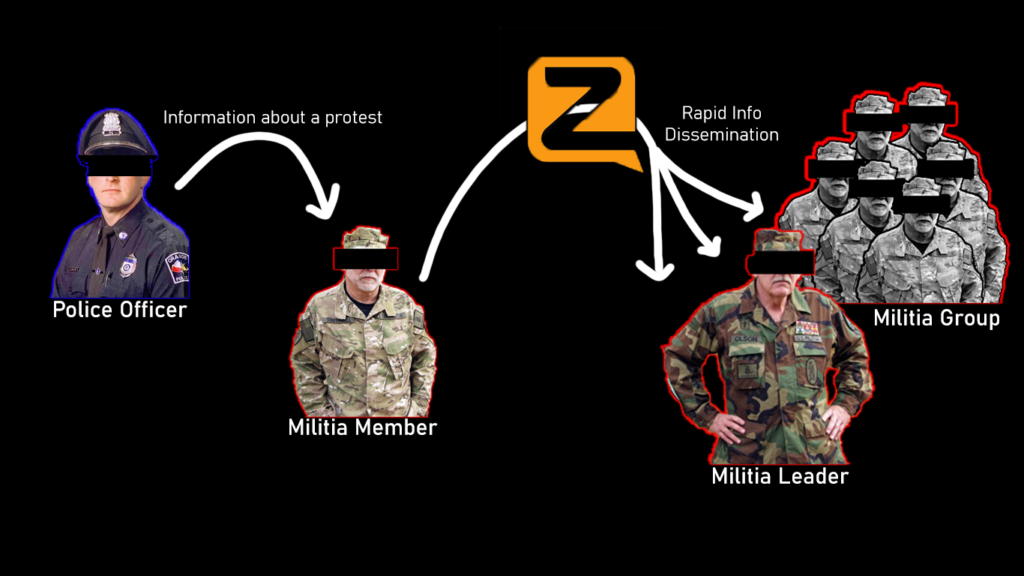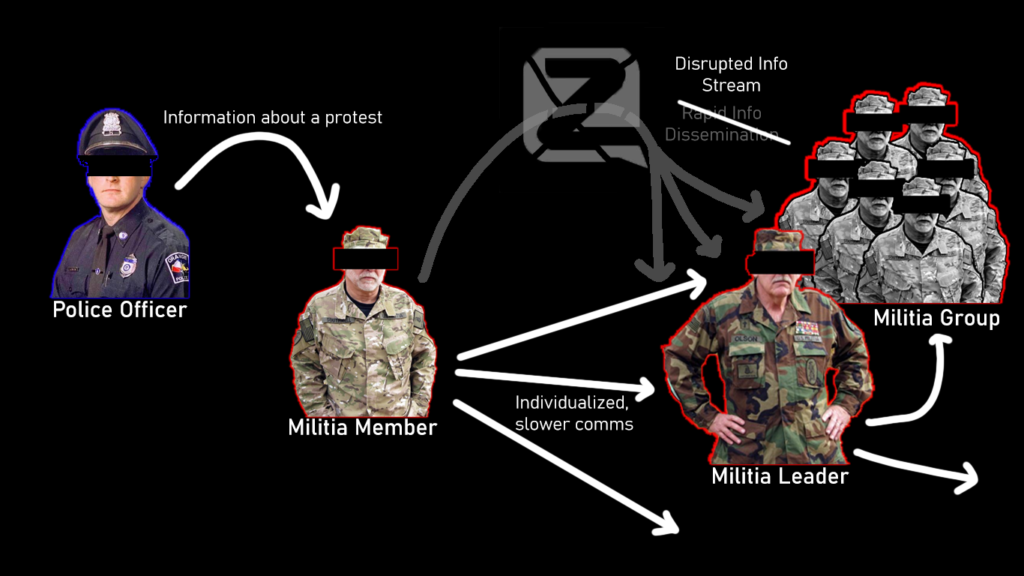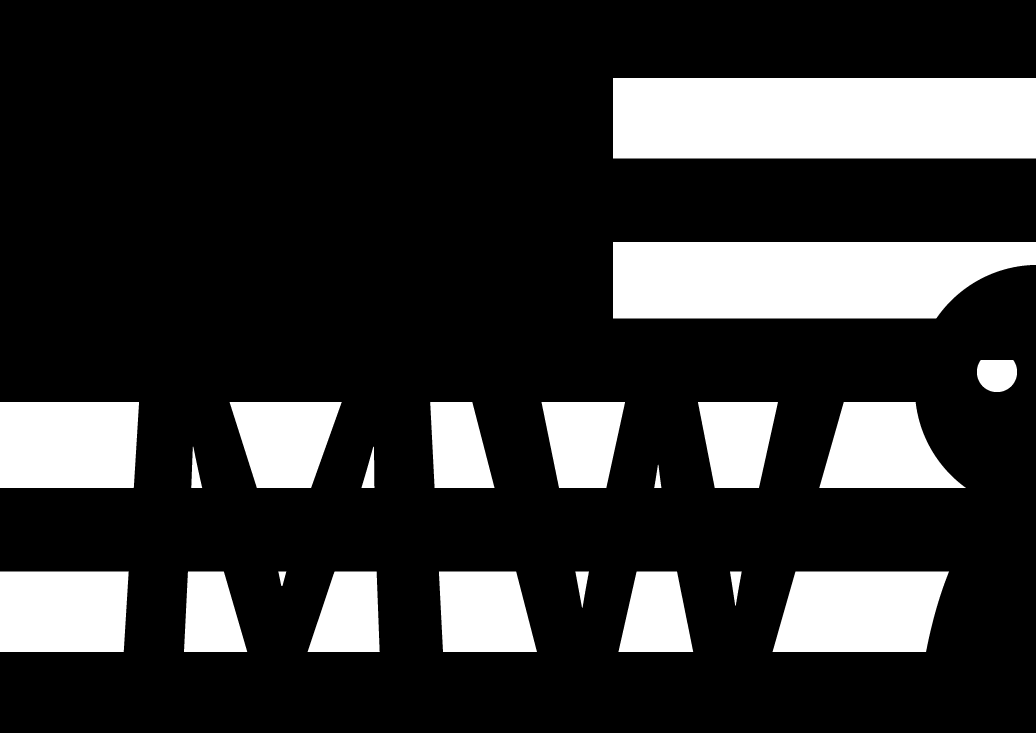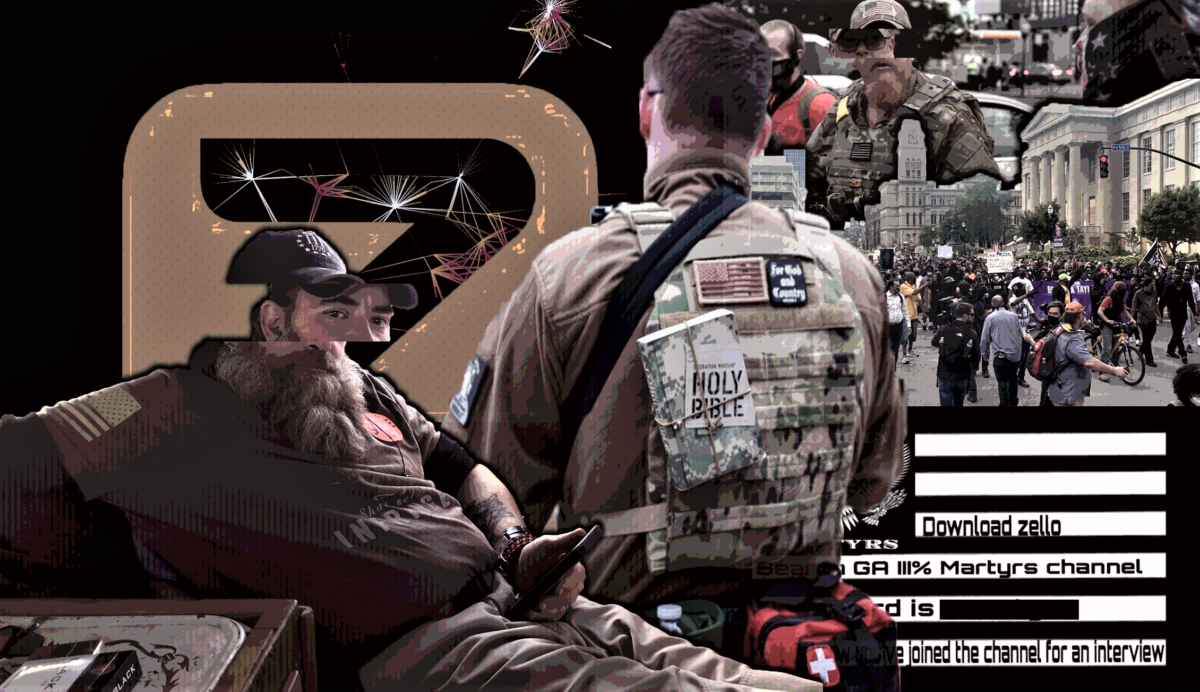This piece is intended as a piece to go alongside Micah Loewinger’s co-created On the Media/MilitiaWatch radio piece covering Zello. In the radio piece, you will hear in their own voices some of the militia groups referenced in this visual article intended to accompany and expand upon that piece. You will also hear some discussion about the app’s leadership and PR response to our investigation.
Next, it is important to note that this visual accompaniment is intended only as a first look into these networks on Zello. More data work is being completed to follow this article and the audio piece it accompanies.
Micah Loewinger has experience with Zello and militia organizing directly, as he reported from a ‘command station’ for Virginia’s 20 January anti-gun regulation rally. This station, as Micah reports in the piece here, was manned by AJ Andrews of the National Patriots Coalition III% (NPC III%), a country-wide movement.
Zello?
Zello is a push-to-talk walkie-talkie app that allows users to create group communication lines across great distances, requiring only an internet or cellular data connection to broadcast one’s voice to a select audience across limitless miles. Their site aims their technology primarily towards Zello’s workplace solutions, ZelloWork, which covers industries such as “Transportation”, “Hospitality” and “Emergency Response”.
They also have a personal and phone app that is available for free use and marketed towards connecting “with family, friends, and your community” via “public and private channels”. It is rated about 4.5/5 on both the iOS and Android stores with hundreds of thousands of ratings each, indicating a massive and mostly-happy userbase.
The app made positive press for being a tool of choice for the Cajun Navy in responding to massive floods in Louisiana in 2016 and Texas in 2017, as reported in The Washington Post. the New Yorker, the Observer, local news like KTBC FOX 7 Austin among countless others. Zello itself has used the Cajun Navy as advertising material on their blog and the Cajun Navy printed information about how to connect to their channel on their site.
What is Social Network Analysis?
Social Network Analysis (SNA) is the set of tools and methodology geared towards analyzing networked interactions in order to better understand social ecosystems and information streams.

There are a number of apps and programs for analyzing data that are structured by relationships within a network, including Gephi, several R packages, Kumu, and about a dozen others. For this project, large excel sheets and Kumu were used for structuring and analyzing the data.
And so by gathering publicly-available information from Zello channels hosted online under zello.com URLs, we were able to generate a network for analysis based on the mod and admin teams of each channel. Here’s a sample of what a Zello channel landing page looks like on their site, this one for a III% group of 133.

The way the data has been coded, these channels have an owner (indicated by the “Updated by” field under channel name), at least one admin (indicated by the “Channel administrators” area of the landing page), and sometimes mods (indicated by the “Channel moderators” section). As one can see from this page, some channels have pretty sizeable moderation teams, which is likely also indicative of the number of people in the group that have at least some influence among the militia group within the overall group’s hierarchy.
These accounts and channels are then associated with one another along this relationship structure, and channels are classified by the ‘character’ of the group they represent (III%, Oath Keeper, Light Foot Militia, Local Militia, etc), as well as their use (General, Recruitment, Intel, etc). A few other points of data, such as length of time since last update, tags used to promote the channel, number of accounts in the channel, and number of accounts blocked from the channel.
What does the Zello militia data look like?
Of our sample of 223 Zello channels, we found 817 total associated moderation team accounts. Drawing connections between these two entity types netted us 1587 connections across these 1040 nodes. For every channel there is one owner and at least one admin of the channel (owner level of connection to the channel is mutually inclusive with admin level, though some channels have many admins). Not every channel has moderators, but those that do often have multiple moderators.
Just looking at the channels that have not been deleted, average group membership is just above 100 people per channel, though the largest channels have around 1000 accounts among their membership. The total sum of the channels’ overall sizes (as of 12 October 2020) is above 21,000, though there is likely substantial overlap between channels, meaning this number is likely a good deal lower.
The average group size is just over 100 members per channel but this is skewed by some of the larger channels, as the median channel size is 31 members.
Zello allows for channels to have tags for organizing the channels within their app, and the most common tags of our initial sample include “Politics” (23), “Local” (20), “News” (17), “Religion” (9), “Humor” (4), and “Technology” (3). 21 of the channels, or about 10% of the overall sample, utilize multiple tags for their channels. Having tags on channels is also correlated with growth in channel memberships, as the average growth of channels with tags that saw membership changes in the last two months is about 4.4%.
About 10% of the overall channels from our sample are explicitly for group recruitment and vetting. These channels are typically used by militia leaders to interview new potential recruits and to convince them to get involved with armed right-wing activism within their sphere of influence. Zello is used for this purpose for a number of reasons and provides a slew of unique tools that a forum or Facebook group cannot when it comes to bringing new militia members into the fold.
Of the 223 channels, nearly 60% are III% affiliated, either through name or aesthetics. If the group itself doesn’t explicitly claim to be a III% movement (through naming themselves as such or identifying themselves as Three Percenters), this sample will use the aesthetics and symbols of the III% brand in order to entice membership and reify community under a particular ideological banner that is highly attractive to many militia activists.
Some graphics and analysis
After importing the network file into Kumu and running a community detection algorithm, here are the top 10 most populous communities colored across the entire network:
100s of communities were detected using the algorithm, partly represented visually in the data by the number of smaller, disconnected channels in the bottom half of the network map above. These little neighborhoods of Zello in many cases represent the organizational space occupied by specific brands of particular militia groups, who often have multiple channels and a smattering of owners, admins, and mods across these channels.
The above graph is a little hard to decipher what the data is telling us, so the following writing will dive into a few visualizations and cross-sections of this data.
The Three Percenter Militia Zello Ecosystem(s)
One of the things that crosses these community divisions, however, are militia channels’ attribution by name or aesthetics to the III% movement writ-large, colored in the following graphic in dark red.
As mentioned above, almost 2/3rds of the overall channel sample are III%-affiliated in some way, despite the multitude of splits within the overall movement (some of which are represented in the graphs).
Related to these splits, one of the disconnected/insular networks within this overall Zello channel network is that of the III% Security Force. Militia groups like the III% Security Force can have major overlap of their channels and administration/moderation teams as shown below (channel nodes sized by overall group membership of the channel):
One of the channesl (the larger one in the graph) has a massive mod team that includes all admins/mods of other channel plus another several other moderators and admins.
The III% Defense Militia Zello network involves a ton of different channels (also with a lot of overlap of the moderation team), but one account “steele001” is highly central to a lot of the most important channels as the owner of the channel, depicted here:
Many of these militias are highly competitive and ridden with all sorts of internal drama from in-fighting as well as infiltration, which can lead to sprees of blocking individuals. This is especially the case for higher-population channels.
Below is a chart of the III% Defense Militia ecosystem with moderation team members in white and the other channels colored based on what percentage of total accounts joining the channel have been blocked (green is a lower rate, red a higher rate).
It’s also worth noting that some activists within the armed right-wing in the US do organize both within clearly III%-branded and III% identified spaces as well as outside of them. For example, this network showing accounts in orange and channels colored either red for III% branding or white for not, shows a highly integrated and heterogenous communication network of right-wing militia-associated accounts.
Some of the non-III% groups included here include “patriot” themed chat-rooms, “emergency response” lines, and Christian armed movements. There are even Oath Keeper themed channels and accounts within this mixed ecosystem.
AJ Andrews, mentioned at the start of this piece and featured in Micah Loewinger’s previous Zello reporting, is highlighted in the above graph, which is itself a subset of the larger network of “patriot” themed chat-rooms of the image before it. He is the direct Zello owner of three III%-themed chat rooms, and admin/mod of other militia-themed channels.
It’s also important to note that III% affiliation does not necessarily denote the most right-wing, conspiratorial, or violent of channels, as our sample includes and 13 QAnon channels, 4 explicitly White Nationalist channels, and 15 Boogaloo channels. Among militias that are not considered III% and are instead in a liminal space between describing themselves as “militia” and “emergency response” (a borderline that many militia groups attempt to straddle for both operational as well as public relations purposes), some of the more troubling parts of the armed right-wing can still yet appear. For example, we can look at the small ecosystem of United States Civilian Forces (USCF) channels.
USCF, and looking beyond our first sample of militias on Zello
The USCF claims, per their wix site, to be a “EMS multi-agency multi-event national disaster response platform” that relies upon “crowdsourced civil defense operations” since 2015. Their Twitter and YouTube accounts are both suspended for violating terms of service at time of writing.
On their self-created “watch list” of open source intel to keep track of are the following:
- #2A Gun Grabs
- COVID19 Tyranny
- Forced Vaccines
- Domestic Terrorists
- Hurricane Season 2020
All but one of these are clear indications of the political leanings of this organization, and despite their disaffiliation with III% branding or any other prominent militia group they represent yet another contingent of the armed right-wing organizing on Zello. While not fully represented in this sample of channels, the owner and primary admin of nearly every USCF channel, 1%Watchdog, runs a series of loosely-affiliated right-wing channels including “USCF Counter Antifa Ops”, “[Worldwide House of Rothschild Empire] INTEL”, “Counter-Jihad” and many others.



The “Counter Antifa” channel has compiled a 20-page document they call a “Counter Antifa Report” that details right-wing news of “Antifa violence”, compiles “Antifa propaganda”, and declares that “Antifa generally listen to Punk music”. The report also assesses the Antifa “Threat” by leading with the following sentence:
“The globalist insurgency hydra has opened up a new front by adding Antifa to its array of heads in a vain attempt to ignite a civil war in the US.”
While discussing the “Rothschild Empire” and referring to the “globalist insurgency hydra” may be thinly-veiled dog whistles for anti-semitism that is well-known to many researchers of the right-wing, some of their information is a little more shouted and direct. For example, their “Counter Antifa Propaganda” section of this document begins with a neo-Nazi meme featuring a Totenkopf and with an (author-obscured) link to a fascist site:
Again, none of the three channels above are even within the 200+ channels within our initial Zello militia network sample and it’s very clear that this small sample is just the tip of the iceberg of what sort of right-wing hate and organizing is happening under Zello’s cover.
It is also worth noting here that 1%Watchdog also owns the most explosively growing channel of the entire 200+ channel sample data set. This channel, aimed at gathering information on 2020 protests, garnered about a 300% growth rate just over a couple of months, despite also committing to an almost 25% block rate of those attempting to join the channel.
Looking further beyond
This first sample of data gathered jointly with On the Media’s Micah Loewinger was enlightening in so many ways and clearly points to Zello offering a haven not only for militia organizing but a long-term Nazi and conspiracy ecosystem. “Long term” is an apt description for some of these channels, too. While it may be difficult to deduce exactly when a channel was created based upon publicly-available information, it is possible to see when a channel was most recently changed by its owner. Using this information, we can therefore gather a value of the minumum length of time that a channel has been on Zello.
From our sample of over 200 channels, at least 70 were over 1 year old. Of our sample, therefore, just under a third of all channels (~31%) were over a year old, having been updated most recently before October 2019.
16 channels, or 7% of our sample data, have been updated most recently 5 or more years ago. These channels includ 5 III% militia channels, 4 Oath Keeper channels, and 4 explicitly White Nationalist and Nazi channels. In fact, the channel we found with the longest “last updated” time was 8 years ago, a channel literally called “white power”.
Another partial metric are those where we were able to observe how many people were online at time of archiving the channel for the data we are using to analyze the channels. This is not to say this is the same thing as an “active channel”, as most pages only required less than a minute of checking to get the primary data we were looking to collect. However, 9 of the non-password-protected channels had a visible number of people online, affording a casual passerby to listen in to communications at the time of visit. Of these channels, a third were explicitly Boogaloo channels, another third were QAnon channels, and the remainder an assortment of III%, state, and unaffiliated militia channels. One of the QAnon channels, the “QAnon Live Emergency Channel” had 7 online and was at least 2 years old, per our previously-identified metrics. One militia channel, “Oklahoma Patriots united” had 9 people online in the channel, or a third of their 27 total members.
Police coordination and response facilitated via voice comms?
On the Media’s Micah Loewinger, in the most recent piece on these channels we’ve gathered data on together, got access to tape from several militia groups, as played on the OTM show here. He very accurately lays out a series of interactions between militia groups and police departments, ranging from dissuasion to direct encouragement.
Militias like the Georgia III% Martyrs appear to have used their Zello chat room to discuss their involvement in monitoring a Black Lives Matter protest in Morrow, Georgia, adding,
“When Payne, Evo, J3 and myself rolled up at Southlake Mall and assisted the Morrow Police Department, we were in full battle rattle and Payne even sighted in on somebody. And they didn’t mess with us.”
Micah reported that the Georgia III% Martyrs responded to his request for comment to deny that they had ever been to the event and the Morrow Police Department never replied to Micah’s request, per the OTM episode.
In this case, it appears that they’re using this chat room (as with other communication methods, certainly) to pass along a record of behavior and nod to potential future action. The Martyrs, of course, also expressed that this interaction with police is highly dependent upon the direction that the militia members pointed their rifles, adding,
“If we go out there trying to buck the system in their eyes, even though it’s our right, that’s when it turns into an issue. They only want us to have our rights if it benefits them.”
In another chat recording featured on the OTM radio episode, the III% Security Force, a regular staple on MilitiaWatch, included the following communications shared in their Zello channel:
“I got word from the Douglas County Sheriff’s Department today that there will be a protest in Douglas County over there at the Civil War Monument in that courthouse. They said within the next week they may reach out and ask for assistance.”
A voice that sounds exactly like the leader of the militia himself replied, “And if possible, we’ll give it.”
In yet another cut of tape featured in the OTM episode by Micah Loweinger, members of the Michigan Home Guard (MHG) Zello channel claimed that the Livingston County Sherriff, Michael Murphy, had secretly reached out to them to ask them to come to provide “extra security” both before he made a public statement discouraging militia involvement in his precinct and after. According to this member of the MHG, the sheriff “came back to MHG… and said, no, I still want you there. I just want you to stand back and make sure nobody sees you more or less”, a rumor in the chat that obviously upset some members looking for greater public support. Sheriff Murphy denies adamantly that he had any contact with the militia.
In this case with the III% Security Force and the Michigan Home Guard, Zello is being utilized (again, almost assuredly amongst an assortment of other communication apps and information systems) to pass along information in coordination for responding to protests. However, in this case, it’s used to allegedly relay a message from a police department to a militia member and to a militia, with a verbal seal of approval likely from the leader of the III% Security Force himself and annoyance from members of the MHG, who said, “pardon me, but that’s bullshit”.
So given what is already known about many militia groups’ communication strategies and structures and what tape was played on the OTM broadcast, here’s a simple graph of how information potentially flows into and through Zello channels towards a broader militia network.

This summer, Facebook and other social media platforms, began to (for pretty much the first time) remove individuals, groups, and communities deemed to be sharing highly dangerous organizing and information-sharing space on their platforms. Facebook’s crackdowns have focused especially on militia groups, Boogaloo pages, and QAnon media platforms.
This loss of key organizing space has resulted in a measurable drop in militia organizing as groups and networks have been rushing to re-integrate elsewhere, to varying levels of success. While there are definitely militia groups that have been able to re-integrate in meaningful ways on their own forums and websites free from the eyes of the public or unsympathetic moderation teams, their capacity does appear to be highly affected by these upheavals.
Given what is known from these impacts, a severance of Zello access would likely disrupt or inhibit many information flows, including flows between police officers and assorted militia activists as such:

Most militia groups use many forms of communication, but losing Zello’s functionality would hinder one mode of communication. It would force some groups to spend time, energy, and human resources on finding a new platform to communicate. Finally, every time that a substantial online group is disrupted, there is a lag time before the group is able to reconstitute itself and there very well may be losses in the overall group population with the jump. This is especially the case with channels that platforms like Zello may deem “dormant”, in that they lose nearly their entire capacity to reignite in response to some event or rumor.
Just looking at this minimal selection of militia and right-wing channels hosted on Zello, it becomes very clear that Zello, like Facebook before the purges, has remained central to much of the US militia organizing structure. This is not a new happening in response to Facebook’s actions but appears to be a long-standing pattern with well-defined information pathways and onboarding procedures developed alongside the gathering of members within official communication channels. Relatedly, should Zello as a company decide to commit to meaningfully impacting the organizing capacity of these groups that have an assortment of views deemed extremist or related to very real violence in the real world either threatened or actively engaged, they could react by taking down channels and restricting accounts.
As an independent researcher working with mostly publicly-available data alongside a radio journalist, we were able to very quickly identify how important these channels are for maintaining the ever-growing memberships of many channels on Zello. These channels are also, of course, growing, something that can be quantified in the data. Of the channels we analyzed, the average change in membership over the past couple of months is +15.2%, and the average growth for those not losing or banning members is a +25.8% expansion in just a couple of months.
From Zello’s own site, they claim the following among “Prohibited Activities” that violate their Terms of Service:

The Oath Keepers and Proud Boys are SPLC-designated groups and the Oath Keepers and Three Percent movement are highlighted groups on one of the SPLC’s “extremism” pages. Their terms specifically citing the UN Security Council sanctions list, a list that is almost entirely Arabic-speaking, DPRK-related, or Iranian-aligned groups with a high international profile. This is a typical pattern for the UNSC’s sanctions projects and confounded by the same forces that, for example, may lead many international courts to focus most of their efforts on African and Arab military dictators rather than a broader sample of other war criminals. It’s an incomplete list of actors potentially looking to organize and coordinate armed activities that have a very real potential for violence, especially in these heightened times of documented militia-associated killings in the street.
In 2016, the Middle East Media Research Institute (MEMRI) claimed in a report that ISIS members and supporters were using Zello to organize chatrooms amongst themselves. According to reporting in WIRED magazine, this report and a list of channels were sent to Zello CEO Bill Moore by MEMRI deputy director Elliot Zweig. 18 months later in March 2018, MEMRI released a follow-up report indicating that these channels were still up. In the response to this MEMRI report, Moore said of some ISIS and ‘jihadi’ channels that, “They should be shut down, and they weren’t, and that’s a problem.” A high-profile court case in 2019 saw the conviction of a man who used Zello to recruit “like-minded people” on Zello to entice them to commit acts of violence wherever they lived. After many cases of these connections to violent groups, organizing, and activities over multiple years, Zello took a stance against these groups and began to finally start removing and restricting these channels and accounts in a more serious way.
This indicates that Zello, under the appropriate public and journalistic pressure, has shown it is willing to moderate and remove material that indicates organizing towards potentially violent and threatening ends. One has to ask how right-wing ‘Islamist’ recruitment differs from right-wing ‘patriot’ recruitment, a distinction that has not yet been made clear in calls for comment made by MilitiaWatch to the company.

